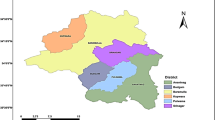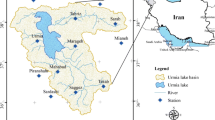Abstract
Trend analysis of reference evapotranspiration (ET0), as a key factor in irrigation programming, has an important role in water resources management. Many parameters affect ET0 and their variations can change its values. In this paper, the effect of temporal variation of meteorological variables including wind speed, temperature, solar radiation and saturation vapor pressure deficit on temporal variations of ET0 was analyzed. Trend analysis of ET0 and its more effective meteorological parameters was accomplished in 30 synoptic stations which are located in Iran using Spearman’s Rho test. The multiple linear regressions were also used to determine the relationship between ET0 trend and the trend of its more effective parameters. Increasing and decreasing trends in ET0 were obtained at annual and seasonal scales. Many studied stations which had decreasing trend in the annual and seasonal periods have been located in the arid climates while all stations which have been located in humid and very-humid climates, had an increasing trend in annual and seasonal periods. The trend results in studied variables showed that annual and seasonal values of wind speed, temperature and saturation vapor pressure deficit decrease however the values of solar radiation increases in most studied stations. Multiple linear regressions results demonstrated that ET0 trend can be calculated by the trend of two more effective variables including wind speed and saturation vapor pressure deficit.









Similar content being viewed by others
References
Allen RG, Pereira LS, Raes D, Smith M (1998) Crop evapotranspiration–guidelines for computing crop water requirements. FAO irrigation and drainage paper 56. Food and Agriculture Organization of the United Nations, Rome
Amirataee B, Montaseri M, Sanikhani H (2015) The analysis of trend variations of reference evapotranspiration via eliminating the significance effect of all autocorrelation coefficients. J Theor Appl Climatol. doi:10.1007/s00704-015-1566-z
Bandyopadhyay A, Bhadra A, Raghuwanshi NS, Singh R (2009) Temporal trends in estimates of reference evapotranspiration over India. J Hydrol Eng 14(5):508–515. doi:10.1061/(ASCE)HE.1943-5584.0000006
Brunetti M, Buffoni L, Maugeri M, Nanni T (2000) Trends of minimum and maximum daily temperatures in Italy from 1865 to 1996. J Theor Appl Climatol 66:49–60. doi:10.1007/s007040070032
Darshana Pandey A, Pandey RP (2013) Analysing trends in reference evapotranspiration and weather variables in the Tons River Basin in Central India. J Stoch Environ Res Risk Assess 27:1407–1421. doi:10.1007/s00477-012-0677-7
Dongsheng Z, Zheng D, Shaohong W, Zhengfang W (2007) Climate changes in northeastern china during last four decades. J Chin Geogr Sci 17:317–324. doi:10.1007/s11769-007-0317-1
Gadgil A, Dhorde A (2005) Temperature trends in twentieth century at Pune, India. J Atmos Environ 39:6550–6556. doi:10.1016/j.atmosenv.2005.07.032
Garbrecht J, Van Liew M, Brown GO (2004) Trends in precipitation, streamflow, and evapotranspiration in the great plains of the United States. J Hydrol Eng 9(5):360–367. doi:10.1061/(ASCE)1084-0699(2004)9:5(360)
Kahya E, Kalayci S (2004) Trend analysis of streamflow in Turkey. J Hydrol 289(1–4):128–144. doi:10.1016/j.jhydrol.2003.11.006
Khalili K, Nazeri Tahrudi M, Khan mohammadi N (2014a) Trend analysis of precipitation in recent two decades over Iran. J Appl Environ Bio Sci 4(1s):5–10
Khalili K, Esfandiary S, Khan mohammadi N, Nazeri Tahrudi M (2014b) Half-century air temperature trends in Iran. J Middle East Appl Sci Tec (JMEAST) 8(4):208–213
Li ZL, Xu ZX, Li JY, Li ZJ (2008) Shift trend and step changes for runoff time series in the Shiyang River Basin, Northwest China. J Hydrol Process 22:4639–4646. doi:10.1002/hyp.7127
Li Z, Li Z, Xu Z, Zhou X (2013) Temporal variations of reference evapotranspiration in Heihe River basin of China. J Hydrol Res 44(5):904–916. doi:10.2166/nh.2012.125
Liu Q, Yang Z, Cui B, Sun T (2010) The temporal trends of reference evapotranspiration and its sensitivity to key meteorological variables in the Yellow River Basin, China. J Hydrol Process 24:2171–2181. doi:10.1002/hyp.7649
Liu L, Xu ZX, Huang JX (2012) Spatio-temporal variation and abrupt changes for major climate variables in the Taihu Basin, China. J Stoch Environ Res Risk Assess 26:777–791. doi:10.1007/s00477-011-0547-8
Maugeri M, Nanni T (1998) Surface air temperature variations in Italy: recent trends and an update to 1993. J Theor Appl Climatol 61:191–196. doi:10.1007/s007040050063
Mikkonen S, Laine M, Makela HM, Gregow H, Tuomenvirta H, Lahtinen M, Laaksonen A (2015) Trends in the average temperature in Finland, 1847–2013. J Stoch Environ Res Risk Assess. doi:10.1007/s00477-014-0992-2
Rezaie H, Khalili K, Khan mohammadi N, Nazeri Tahrudi M (2014) Surface air temperature trends during the last 20 years in Iran. J Appl Environ Bio Sci 4(1s):40–46
Rosmann T, Domínguez E, Chavarro J (2016) Comparing trends in hydrometeorological average and extreme data sets around the world at different time scales. J Hydrol Reg Stud 5:200–212. doi:10.1016/j.ejrh.2015.12.061
Shadmani M, Marofi S, Roknian M (2012) Trend analysis in reference evapotranspiration using Mann-Kendall and Spearman’s Rho tests in arid regions of Iran. J Water Resour Manag 26:211–224. doi:10.1007/s11269-011-9913-z
Shi Z, Xu L, Yang X, Guo H, Dong L, Song A, Zhang X, Shan N (2016) Trends in reference evapotranspiration and its attribution over the past 50 years in the Loess Plateau, China: implications for ecological projects and agricultural production. J Stoch Environ Res Risk Assess. doi:10.1007/s00477-015-1203-5
Tabari H, Hosseinzadeh-Talaee P (2011) Recent trends of mean maximum and minimum air temperatures in the western half of Iran. J Meteorol Atmos Phys 111:121–131. doi:10.1007/s00703-011-0125-0
Tabari H, Marofi S, Aeini A, Talaee PH, Mohammadi K (2011) Trend analysis of reference evapotranspiration in the western half of Iran. J Agric Forest Meteorol 151:128–136. doi:10.1016/j.agrformet.2010.09.009
Tabari H, Aeini A, Hosseinzadeh Talaee P, Shifteh Some’e B (2012) Spatial distribution and temporal variation of reference evapotranspiration in arid and semi-arid regions of Iran. J Hydrol Process 26:500–512. doi:10.1002/hyp.8146
Temesgen B (1996) Temperature and humidity data correction for calculating reference evapotranspiration at nonreference weather stations. Utah State University, Logan
Tonkaz T, Çetin M, Kâzım T (2007) The impact of water resources development projects on water vapor pressure trends in a semi-arid region, Turkey. J Clim Change 82:195–209. doi:10.1007/s10584-006-9160-0
Wang W, Van Gelder PHAJM, Vrijling JK, Ma J (2005) Testing and modelling autoregressive conditional heteroskedasticity of streamflow processes. J Nonlinear Processes Geophys 12:55–66. doi:10.5194/npg-12-55-2005
Wang W, Shao Q, Yang T, Peng S, Yu Z, Taylor J, Xing W, Zhao C, Sun F (2013) Changes in daily temperature and precipitation extremes in the Yellow River Basin, China. J Stoch Environ Res Risk Assess 27:401–421. doi:10.1007/s00477-012-0615-8
Wang X, Yang T, Li X, Shi P, Zhou X (2016) Spatio-temporal changes of precipitation and temperature over the Pearl River basin based on CMIP5 multi-model ensemble. J Stoch Environ Res Risk Assess. doi:10.1007/s00477-016-1286-7
Xu CY, Gong LB, Jiang T, Chen DL, Singh VP (2006) Analysis of spatial distribution and temporal trend of reference evapotranspiration and pan evaporation in Changjiang (Yangtze River) catchment. J Hydrol 327:81–93. doi:10.1016/j.jhydrol.2005.11.029
Yaning C, Changchun X, Xingming H, Weihong L, Yapeng C, Chenggang Z, Zhaoxia Y (2009) Fifty-year climate change and its effect on annual runoff in the Tarim River Basin, China. J Quat Int 208(1–2):53–61. doi:10.1016/j.quaint.2008.11.011
Yue S, Hashino M (2003) Temperature trends in Japan: 1900–1996. J Theor Appl Climatol 75:15–27. doi:10.1007/s00704-002-0717-1
Yue S, Pilon P, Cavadias G (2002) Power of the Mann-Kendall and Spearman’s tests for detecting monotonic trends in hydrological series. J Hydrol 259:254–271. doi:10.1016/S0022-1694(01)00594-7
Zaninović K, Gajić-Čapka M (2000) Changes in components of the water balance in the Croatian Lowlands. J Theor Appl Climatol 65:111–117. doi:10.1007/s007040050008
Zhang X, Harvey KD, Hogg WD, Yuzyk R (2001) Trends in Canadian streamflow. J Water Resour Res 37(4):987–998. doi:10.1029/2000WR900357
Author information
Authors and Affiliations
Corresponding author
Rights and permissions
About this article
Cite this article
Khanmohammadi, N., Rezaie, H., Montaseri, M. et al. The application of multiple linear regression method in reference evapotranspiration trend calculation. Stoch Environ Res Risk Assess 32, 661–673 (2018). https://doi.org/10.1007/s00477-017-1378-z
Published:
Issue Date:
DOI: https://doi.org/10.1007/s00477-017-1378-z




